3. Superfood Nutrition
Spirulina is called a superfood because its nutrient profile and unusual phytonutrients are more potent than any other food, plant, grain or herb.
Its 65% protein content is higher than any other natural food. Yet, an even greater value is found in its concentration of vitamins and minerals. Three to ten grams a day delivers impressive amounts of beta carotene, vitamin B-12 and B complex, iron, essential trace minerals and gamma-linolenic acid. Beyond vitamins and minerals, spirulina is rich in pigments, polysaccharies and other nutrients that benefit health.
For undernourished people in the developing world, spirulina brings quick recovery from malnutrition. In Western overfed food culture loaded with unhealthy and depleted foods, spirulina can renourish our bodies and renew our health.
It is legally approved as a food or food supplement in Europe, Japan and many other countries around the globe. The United States Food and Drug Administration confirmed in 1981 that spirulina is a source of protein and contains various vitamins and minerals and may be legally marketed as a food supplement. Spirulina has GRAS status (Generally Accepted as Safe).
Today’s food is lower in essential nutrients than foods produced 50 years ago. Farming practices have depleted our soils of minerals. Microorganisms in the soil contributing the valuable mineral content are declining because the overuse of chemical fertilizers destroys these microorganisms. At the same time, stress from environmental pollutants and lifestyle demands have increased dietary requirements for certain essential nutrients. Today, at least some supplements are used by almost everyone.
Most people believe it is better to get nutrients from natural foods. Since many conventional foods are nutrient depleted, more people are taking spirulina and green superfoods. These whole foods offer functional nutrients, new frontiers for disease prevention research, way beyond isolated vitamin and mineral supplements.
Digestible protein and amino acids, low fat and calories
Spirulina has the highest protein of any natural food (65%); more than animal and fish flesh (15-25%), soybeans (35%), dried milk (35%), peanuts (25%), eggs (12%), grains (8-14%) or whole milk (3%).
Spirulina cell walls are composed of soft mucopolysaccharides, making it easily digested and assimilated, especially important for people suffering from intestinal malabsorption. Typically, many older people have difficulty digesting complex proteins, and are on restricted diets. They find spirulina’s protein easy to digest. Spirulina is effective for victims of malnutrition diseases like kwashiorkor, where intestinal absorption has been damaged.
Spirulina’s fat content is only 5%, far lower than almost all other protein sources. Ten grams has only 36 calories and virtually no cholesterol. This means spirulina is a low-fat, low-calorie, cholesterol-free source of protein.
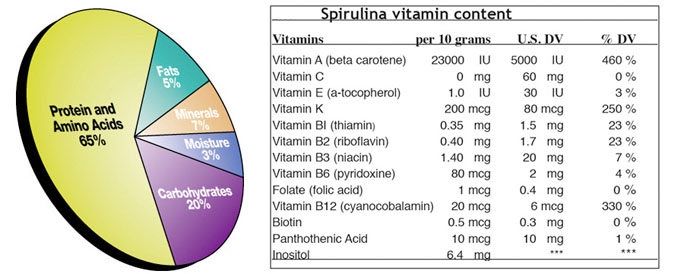
Potent vitamins, protectors of health
Beta Carotene. Spirulina is the richest beta-carotene food, ten times more concentrated than carrots. Ten grams provide 460% of the U.S. Daily Value (DV) of Vitamin A. Human bodies convert beta carotene to Vitamin A only as needed. Vitamin A deficiency is one of the most serious malnutrition diseases in the developing world, leading to blindness.
Beta carotene has therapeutic effects, including reducing serum. Cancer health authorities have published studies showing beta carotene may reduce risks of all kinds of cancers. Since increase in cancer rates seems to be caused by environmental factors, especially diet, these risks can be reduced by increasing protective factors, especially beta carotene, in the diet.
Spirulina contains an antioxidant complex of ten carotenoids. These mixed carotenes and xanthophylls function at different sites in the body and work synergistically with the other essential vitamins, Vitamin E, minerals and phytonutrients in spirulina. Even if you don’t eat the recommended 4 to 9 servings of fruits and vegetables every day, get natural carotenoid antioxidant protection from spirulina every day.
Vitamin B-12 and B-complex vitamins. Spirulina is the richest source of B-12, higher than beef liver, chlorella or sea vegetables. B-12 is necessary for development of red blood cells, especially in the bone marrow and nervous system. Although primary B-12 deficiencies, pernicious anemia and nerve degeneration, are quite rare, because B-12 is the most difficult vitamin to get from plant sources, vegetarians have taken to spirulina.
Ten grams contain 20 mcg of Vitamin B-12, 330% DV, using microbiological assay. There has been scientific controversy over the methodology used to measure Vitamin B-12 and its analogs. Yet, in 30 years, there have been no complaints of a vitamin B-12 deficiency from spirulina consumers, including children and vegetarians.
One tablespoon provides significant quantities of thiamin (23% DV), riboflavin (23% DV) and niacin (7% DV). Spirulina is a richer source of these vitamins than common whole grains, fruits and vegetables and some seeds. Other B vitamins, B-6, niacin, biotin, panthothenic acid, folic acid, inositol and Vitamin E are also present in smaller amounts.
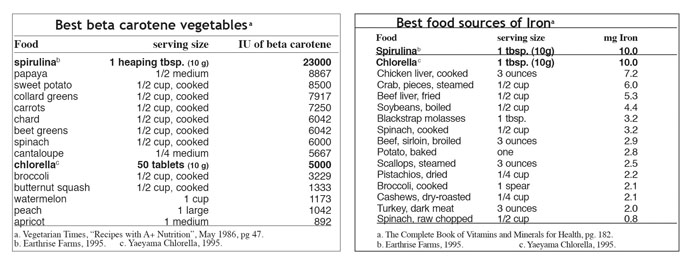
Naturally colloidal minerals
Algae absorb trace minerals while growing and these are well assimilated by the human body. Its mineral content depends on where it is grown and the minerals in the water.
The best natural iron supplement. Iron is the most common mineral deficiency worldwide, especially for women, children and older people. Women on weight loss diets typically do not get enough iron, and can become anemic. Iron is essential for strong red blood cells and a healthy immune system. Spirulina is a rich iron food, 10 times higher than common iron foods. Ten grams can supply up to 10 mg of iron, 55% RDV.
Spirulina iron is easily absorbed. It is theorized that its blue pigment, phycocyanin, forms soluble complexes with iron and other minerals during digestion making iron more bioavailable. Hence, iron in spirulina is over twice as absorbable as the form of iron in vegetables and most meats and 60% better absorbed than iron supplements such as iron sulfate.
Calcium, magnesium, zinc and trace minerals. Spirulina is a concentrated calcium food, supplying more, gram for gram, than milk. Ten grams supply 7% DV for calcium. Calcium is important for bones and neural transmissions to the muscles and deficiencies can lead to osteoporosis in older women. Ten grams supply 10% DV for magnesium, one of the most concentrated magnesium foods. Magnesium facilitates absorption of calcium and helps regulate blood pressure. Spirulina is low in sodium, and is no problem for those on salt-restricted diets.
Humans need dozens of essential trace minerals for the functioning of enzyme systems and many other physiological functions. Deficiency of trace minerals in the typical diet are thought to be widespread. Ten grams supply manganese (25% DV), chromium (21% DV), selenium (14% DV), copper (6% DV) and zinc (2% DV).
Essential fatty acids
Humans require dietary essential fatty acids (EFA). Spirulina has 4 to 7% lipids, and most of these are essential fatty acids. Ten grams have 225 mg of EFA as linoleic and gamma-linolenic acid (GLA). Ten grams provide 8 to 14% DV, depending on sex and age group.
GLA is the precursor to the body’s prostaglandins – master hormones that control many functions. Dietary saturated fats and alcohol can cause in GLA deficiency and suppressed prostaglandin formation. Studies show GLA deficiency figures in many diseases and health problems, so a food source of GLA can be important. The other known sources of dietary GLA are mother’s milk and oil extracts of evening primrose, black currant and borage seeds.
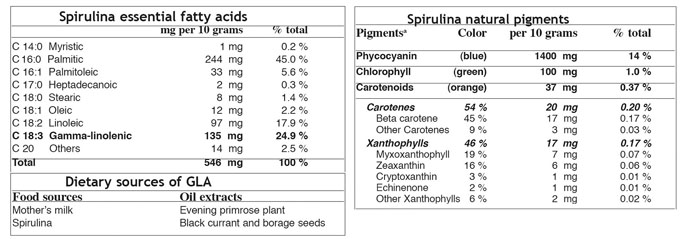
A rainbow of pigments and phytonutrients
These functional nutrients have no Recommended Daily Value, but are known to benefit health. They include pigments and polysaccharides. Pigments help synthesize enzymes necessary for regulating the body’s metabolism. Spirulina’s dark color comes from natural pigments that harvest different wave lengths of sunlight.
Phycocyanin (algae-blue). This protein complex is about 14% of spirulina. Phycocyanin evolved a billion years before chlorophyll and may be the precursor to chlorophyll and hemoglobin. Much research suggests it stimulates the immune system.
Chlorophyll (nature’s green magic). Chlorophyll is known for cleansing and detoxifying. Sometimes called ‘green blood’ because it looks like the hemoglobin molecule in human blood. Spirulina’s beneficial effect on anemia could be due to this similarity of chlorophyll and hemoglobin and its high bioavailable iron. Spirulina has 1% chlorophyll, one of nature’s highest levels, and Chlorella has 2 to 3%.
Carotenoids (natural antioxidants). About half of the yellow/orange pigments in spirulina are carotenes: Alpha, Beta and Gamma. About half are xanthophylls. Although beta carotene is best known, this mixed carotenoid complex functions at different sites in the body and works synergistically to enhance antioxidant protection.
Polysaccharides. Spirulina contains 15 to 25% carbohydrate and sugar. The primary forms of carbohydrates are rhamnose and glycogen, two polysaccharides easily absorbed by the body with minimum insulin intervention. Spirulina offers quick energy, without taxing the pancreas or precipitating hypoglycemia.
Glycolipids and Sulfolipids. When NCI announced that sulfolipids in blue-green algae were ‘remarkably active’ against the AIDS virus, attention was focused on the sulfolipid containing glycolipids. 40% of the lipids are glycolipids and sulfolipids range from 2-5%.
Health benefits beyond the nutritional profile
For over 30 years, people have reported heath benefits from small daily supplements of algae, like spirulina. The nutritional profile of algae protein, vitamins and minerals, however impressive, does not fully account for these therapeutic results. But a remarkable body of published scientific evidence has been accumulating from around the world, explaining how as little as 3 to 5 grams of spirulina per day, one teaspoon or 10 tablets, can be effective in supplying some extraordinary health benefits.
Why Spirulina? | 1. Original Lifeform | 2. Human Rediscovery | 3. Superfood Nutrition
4. Health Benefits | 5. Cultivation Worldwide | 6. Products and Markets | 7. Future of Spirulina
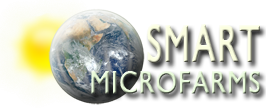
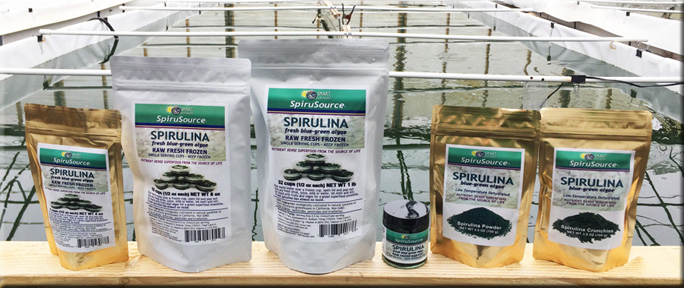
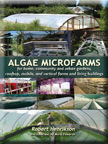
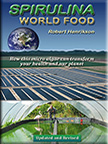 SPIRULINA
SPIRULINA